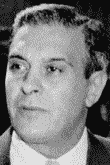d. Unknown.
Giuseppe Esposito, also known as Giuseppe Randazzo and Vincenzo Rebello, served as lieutenant to the infamous Antonino Leone back in 1874 Sicily. He emigrated to the U.S. and briefly found underworld success in New Orleans before being captured by private detectives and deported to Italy to stand trial for murder.
Esposito and Leone are believed to have been responsible for the kidnaping of English businessman John Forester Rose. (According to legend, they sent several of his body parts back to his family with ransom demands). The two leaders were cornered by Italian police in 1875, but Esposito escaped to become the new boss of the island's most feared band of central hill-country brigands.
After some of Esposito's closest allies were captured, he turned himself in to friendly authorities in Alia, Sicily. Charged with a number of crimes, including murder and extortion, Esposito was transported to Palermo to stand trial. During the trip, he escaped. His escape appears to have been organized by Palermo Mafiosi, with whom he had at least friendly relations.
In the late 1870s, Esposito fled to New York via Marseilles, France. He quickly moved on to New Orleans. Adopting a new name, Vincenzo Rebello, Esposito married and began to settle into a life of crime. He was immediately recognized as leader by the various Mafia factions already in place in New Orleans. Esposito and his right hand man Joe Provenzano quickly controlled much of the profitable activity on the New Orleans docks and in the produce markets.
Esposito was betrayed by a New Orleans associate known only by the code name of Panesolo. Panesolo sent word to Italian authorities that Esposito was living in the Crescent City. Private detectives of the Mooney and Boland firm were hired to track him down. New Orleans Police Detectives Mike and David Hennessy (cousins) aided by arresting Esposito near the St. Louis Cathedral on July 5, 1881. Esposito was quickly transported to New York for an extradition hearing.
Overwhelming support from the Sicilian community there and from New Orleanians who traveled to testify on his behalf, coupled with Esposito's insistence that the authorities had misidentified him, delayed the proceedings until he could be positively identified in late September.
Upon his return to Italy, he was convicted of murders in Rome and jailed for life. Some of his former allies in New Orleans converted his possessions there to their own use and failed to provide for a wife and children he left behind. From his Italian jail cell, Esposito tried unsuccessfully to sue those New Orleanians.
Esposito's New Orleans crime organization split into two factions: the Stuppagghieri Mafia commanded by the Matranga family and a Giardinieri Mafia led by the Provenzano clan. The split eventually led to a number of deaths, including the 1890 assassination of New Orleans Police Chief David Hennessey.
Some historians doubt that Esposito was a proper Mafioso, insisting that he was no more than a bandit (and forgetting that the traditional, honored society of the Sicilian Mafia had largely degenerated into a collection of thieves, cut-throats and political radicals by the mid-1870s). In his History of New Orleans, author John Kendall defined the "brigand" view of Esposito:
"Esposito had terrorized the vicinity of Palermo. From boyhood he had been a criminal. In his maturity he was a mountain desperado, plundering, burning, and murdering. Captured by the Italian police after a desperate battle, in which his band of brigands was destroyed, he escaped from custody, and fled to America. The press teemed with stories of his terrible exploits in Italy, and he was sought throughout the world..."
However, the FBI later asserted that Esposito "was the first known Sicilian Mafia member to emigrate to the United States. He and six other Sicilians fled to New York after murdering eleven wealthy landowners, the chancellor and vice chancellor of a Sicilian province." The FBI account leans very strongly on the word "known," as Mafia organizations existed at least in New Orleans and New York at the time Esposito arrived.
Read more:









